PEC Zwolle is a highly respected Dutch football club with a dedicated fan base and a proud history.
The club’s most successful period came in the mid-1970s when they won the Dutch Cup in 1977 and reached the final again in 1978. In recent years, the club has had a resurgence and won the Dutch Cup again in 2014, as well as reaching the final of the same competition in 2015.
Zwolle suffered relegation from the Eredivisie last season as they finished rock bottom, having only picked up 27 points all season. This came as a bitter disappointment to the club as they had achieved a reasonable mid-table finish in the 2020/21 season and were looking to build on that. Current manager Dick Schreuder (brother of Alfred Schreuder, who most recently struggled to follow in the footsteps of Erik ten Hag at Ajax) has been in his post since November 2021 with the club showing great faith in his abilities to guide them back to the Eredivisie.
Schreuder is gaining many plaudits from fans for the stylish and wonderfully fluid football that he has brought to PEC Zwolle. With the team currently occupying first place in the Eerste Divisie, three points ahead of second-placed Heracles, now is a great time to look into the style of football that has propelled the team to the top of the table and that so many Zwolle fans have enjoyed watching this season.
This tactical analysis will look into Schreuder’s tactics at Zwolle and assess precisely why they have been so successful during the current campaign and are on course to bounce back into the top flight at the first time of asking.
Data analysis and preferred formations
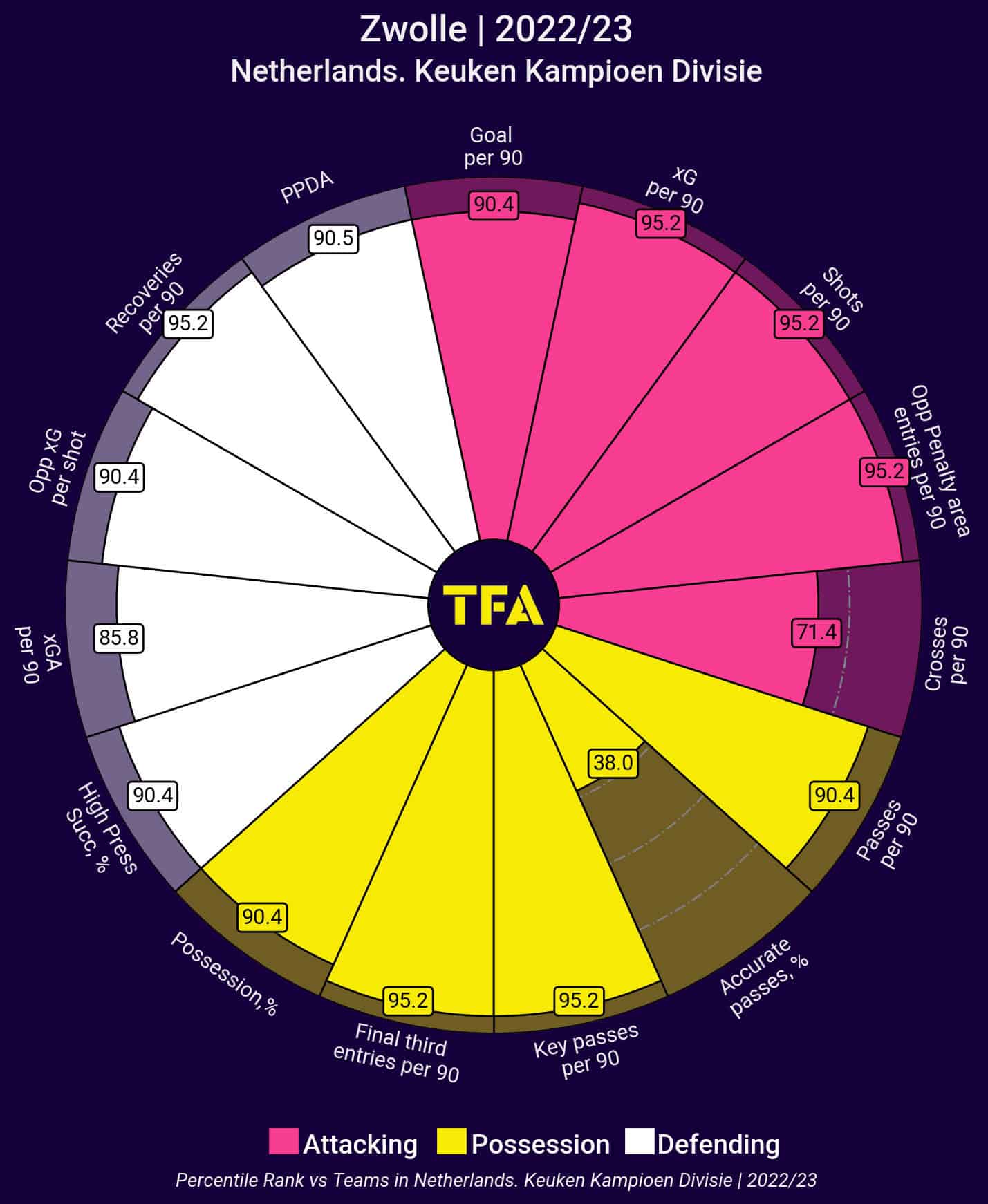
Before we begin this analysis, let’s take a look at what we can infer from the data behind PEC Zwolle’s impressive season so far. Let’s take a look at the pizza chart which shows us Zwolle’s percentile rankings compared to their divisional rivals. We can clearly see that Schreuder’s team excels in a lot of areas.
Firstly we can see they are one of the best-performing teams in terms of goals per 90, however, there is a slight underperformance compared to their number of expected goals. We can also see that under Schreuder, Zwolle likes to play something of a high-pressing game as their percentile rankings are high in terms of their high press success, PPDA and recoveries per 90.

The graphic above shows the formations that Schreuder has favoured the most during the current campaign. As we can see, he mostly uses a 3-4-1-2 formation which can sometimes become more of a 3-5-2 formation in more defensive instances. The three centre-backs offer a solid defensive foundation, while the four midfielders and two forwards provide enough attacking options to create scoring opportunities.
Additionally, this tactical setup allows for greater control of the midfield, which is crucial for dominating possession and controlling the flow of the game. As we saw from the pizza chart, this is something that Zwolle like to do during their games this season.
Moreover, the attacking midfielder, who plays behind the two strikers, can act as a creative playmaker, providing assists and scoring goals. This player can also drop deeper to help in midfield if needed, and then a more defensively-minded midfielder can drop back which creates the 3-5-2 structure.
Finally, there are plenty of opportunities to execute quick transitions from defence to attack, with the attacking midfielder and strikers able to quickly break forward into space. The midfielders can also provide support for the attack, creating multiple options for the ball carrier.
High pressing their way to success
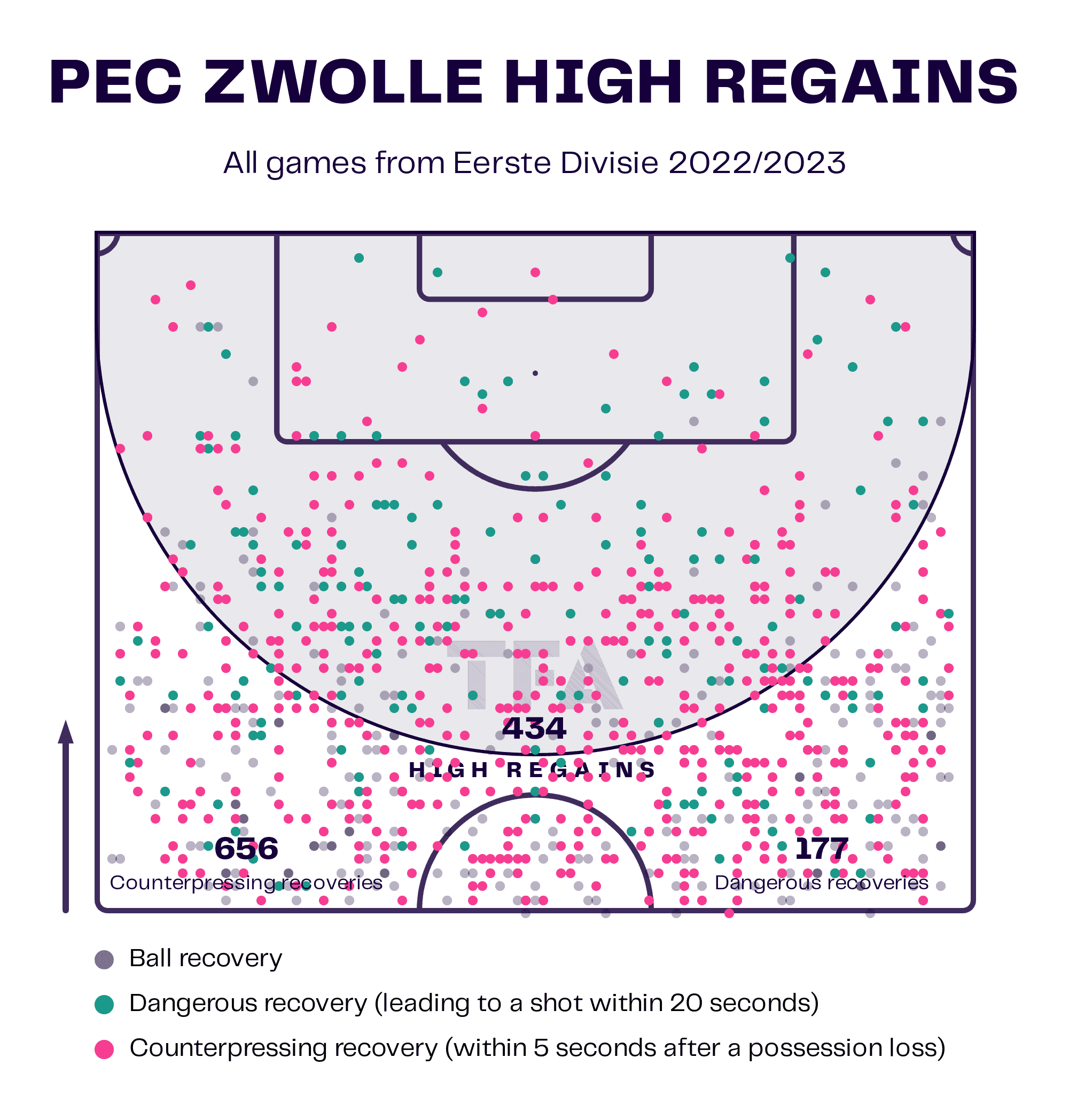
When watching Zwolle this season, the first thing that becomes apparent is their desire to press incredibly high up the pitch to force errors from the opponent. We suspected from the pizza chart that this would be the case and the data visual above confirms this. So far this season, Zwolle have completed 656 counter-pressing recoveries with 434 of those regains in the opposition defensive third. Additionally, 177 of those counter-pressing recoveries have been classed as ‘dangerous’ meaning that they led to a shot within 20 seconds of Zwolle recovering the ball.
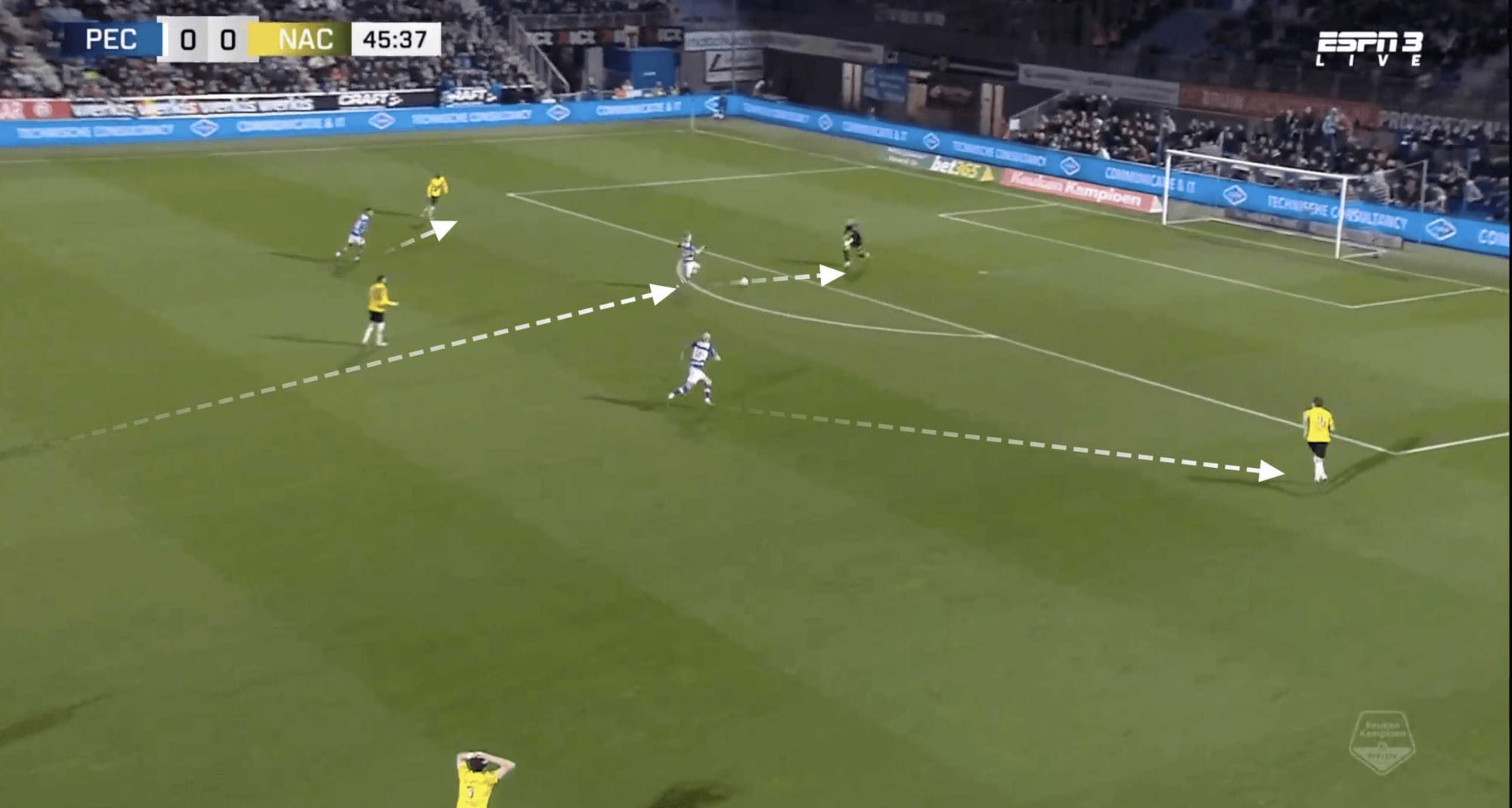
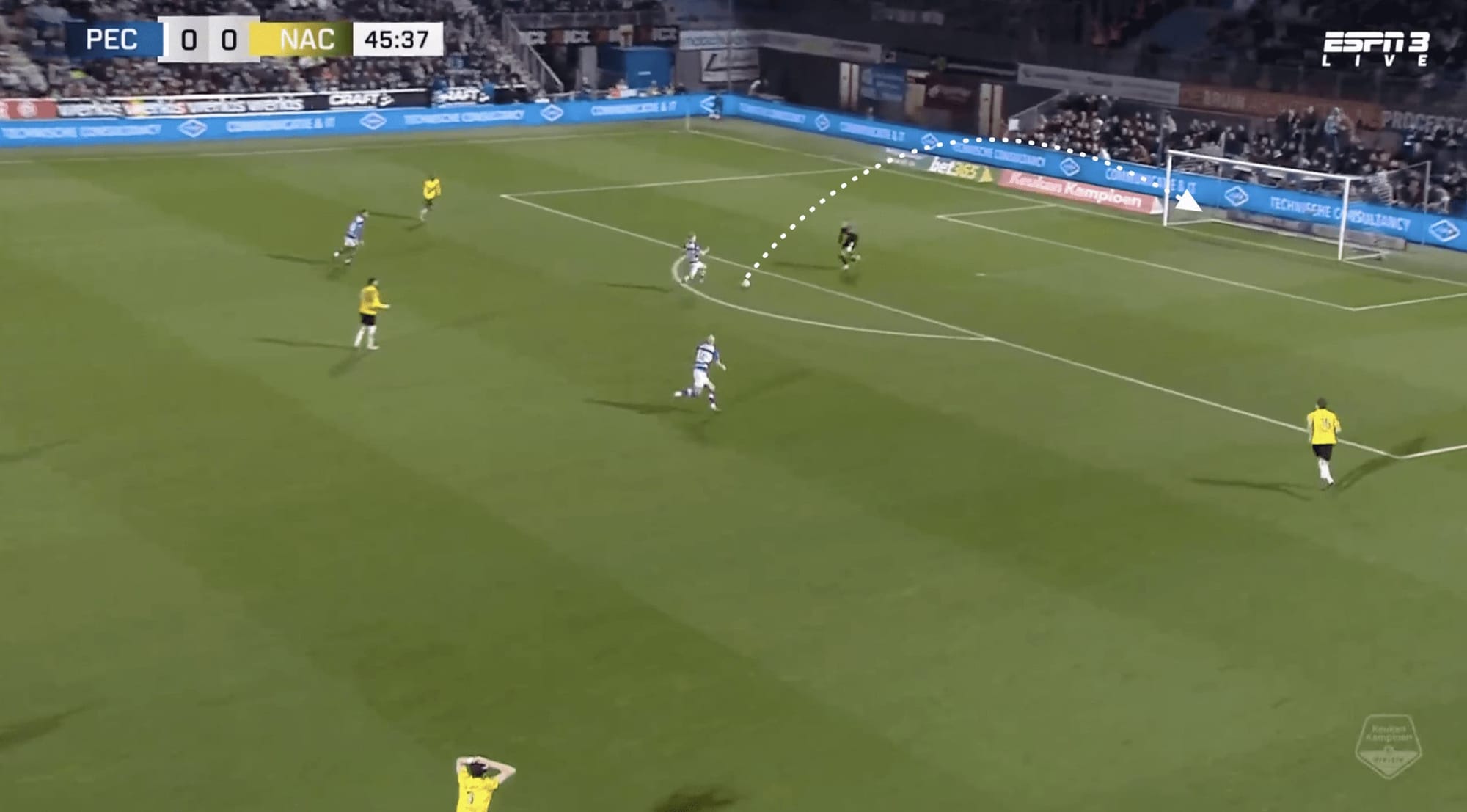
Figures 1.1 and 1.2 show us just how effective the press can be for this Zwolle team. The opposition, in this case NAC Breda, is looking to build up from the back, one of the defenders has passed the ball back to the goalkeeper. It is at this point the Zwolle press springs into action. The attackers cut off the passing lanes and as a result, the goalkeeper panics and plays the ball against the on-rushing Zwolle forward and it bounces into an empty net putting the home side 1-0 up. With an average PPDA of 7.57 this season, it is clear that this tactical choice from Schreuder is proving to be very effective as Zwolle look to gain promotion.
High pressing in football is an effective tactic that many teams use to disrupt their opponent’s build-up play and gain possession of the ball in dangerous areas as shown in Figure 1.1. By actively closing down the opposition players in their own half, a team can limit their time and space on the ball, forcing them into making mistakes or playing long, hopeful passes.
One key benefit of high pressing is that Zwolle can prevent the opposition from building up momentum and gaining control of the game. By constantly pressuring the opposition players, Schreuder’s team can disrupt their passing patterns and force them to play out of their comfort zone, ultimately leading to turnovers and opportunities to score.
Moreover, by analysing the opposition’s playing style and individual players, it is possible to target certain areas of the pitch to press more aggressively, forcing the opposition into making errors or taking risks that can be exploited. For example, Schreuder and his coaching staff may have concluded that the NAC Breda goalkeeper does not cope well under pressure so triggering a press when he receives the ball is more likely to result in a turnover or in the specific case shown above, a goal as we see in Figure 1.2. This is in keeping with the Dutch style of football which emphasises attacking play, with a focus on playing in the opposition half of the pitch.
Overloads to create space
Another aspect of Zwolle’s attacking play under Schreuder is the way they use overloads, this is a common way to shift the opposition’s defensive structure and create scoring opportunities. There are a couple of ways this can be effective; by actively committing more players to one side of the pitch, a team can create numerical superiority, which can lead to several advantages. In Zwolle’s case though, it is more often that these overloads create space on the opposite flank where a Zwolle player will be waiting for a quick switch of play, thus catching the opposition off guard.
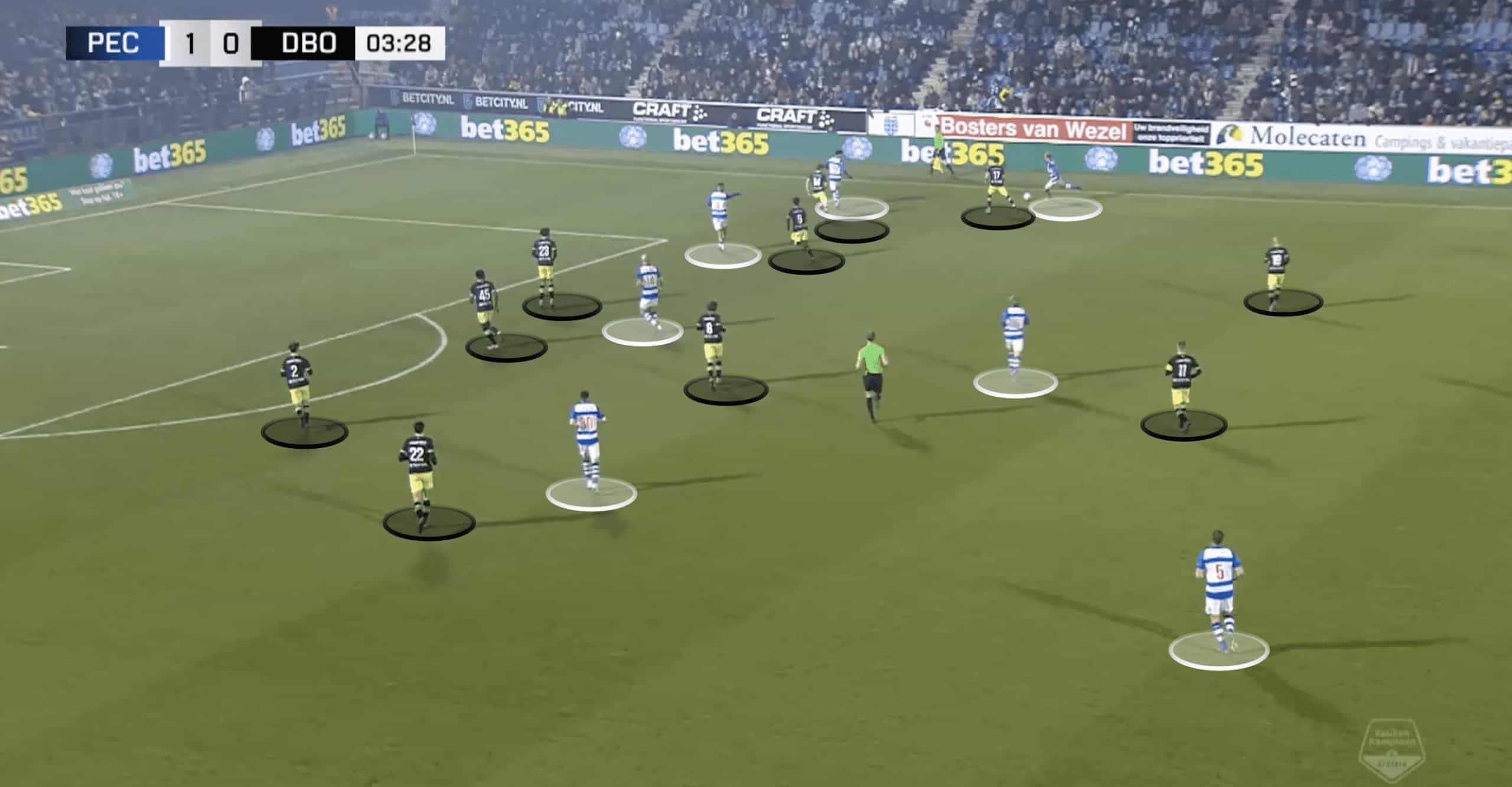
Here, for instance, we can see that the Zwolle players have dragged the opposition in its entirety over to the attacking right side of the pitch. With the opposition preoccupied, expecting an attack to come from the right side, the Zwolle players quickly execute a switch as shown in figures 2.2 and 2.3.
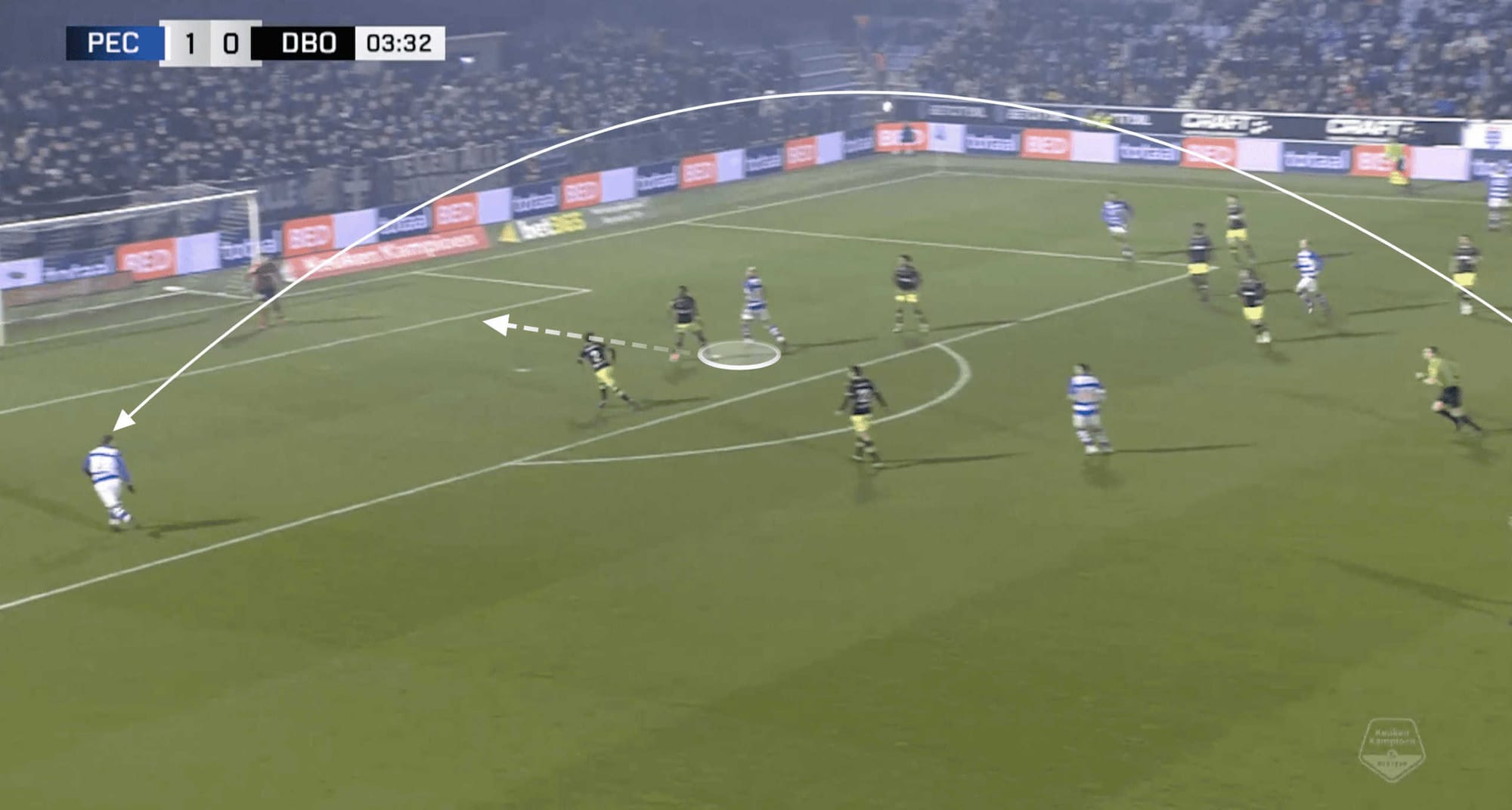
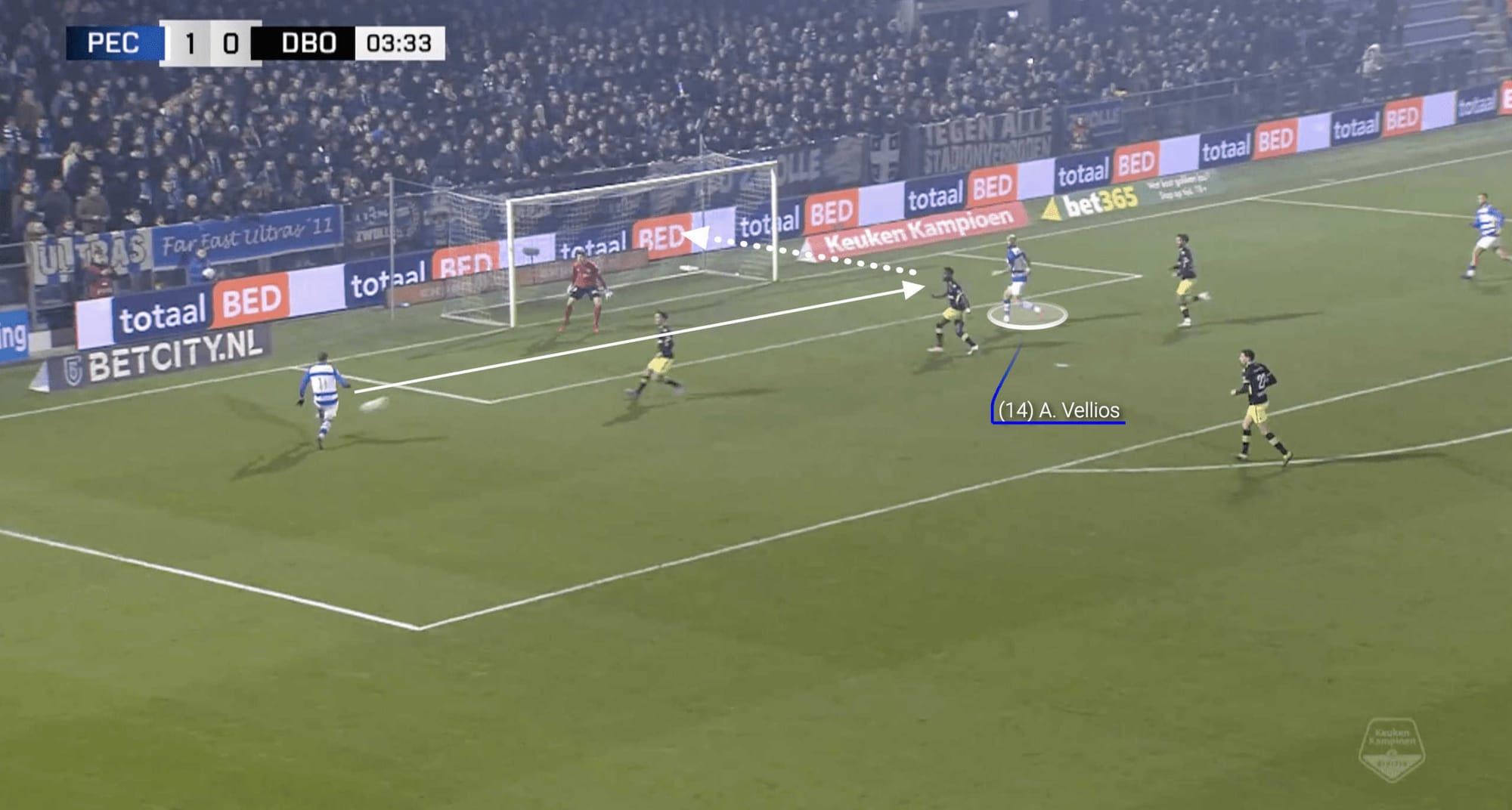
As we can see in Figure 2.2, there was a Zwolle player waiting for the ball to be played over to the left side. As a result of the right-side overload, he has plenty of time and space to play a ball across the face of the goal for Vellios to tap in. This goal was a consequence of Zwolle creating a numerical overload on their right side and swiftly switching the play over to the left where there was plenty of space to exploit.
Schreuder’s team are more than happy to retain possession whilst they look to create these overloads. So far this season they have averaged 57.82% possession per 90. Additionally, they average 183.29 lateral passes per 90 which tells us they look to pass the ball from left to right and vice versa whilst looking to create an opening or an overload.
Rotations in attack
It would be remiss if we didn’t talk about the Dutch way of playing that is prevalent throughout Schreuder’s tactics at PEC Zwolle. Another hallmark of this PEC Zwolle team under Schreuder’s leadership is the use of a fluid and interchangeable system of play. Players are encouraged to move freely around the pitch, interchanging positions with each other, and as we saw previously, creating numerical overloads in various areas of the pitch. This allows the team to maintain possession of the ball, control the tempo of the game, and create scoring opportunities through intricate passing and movement.
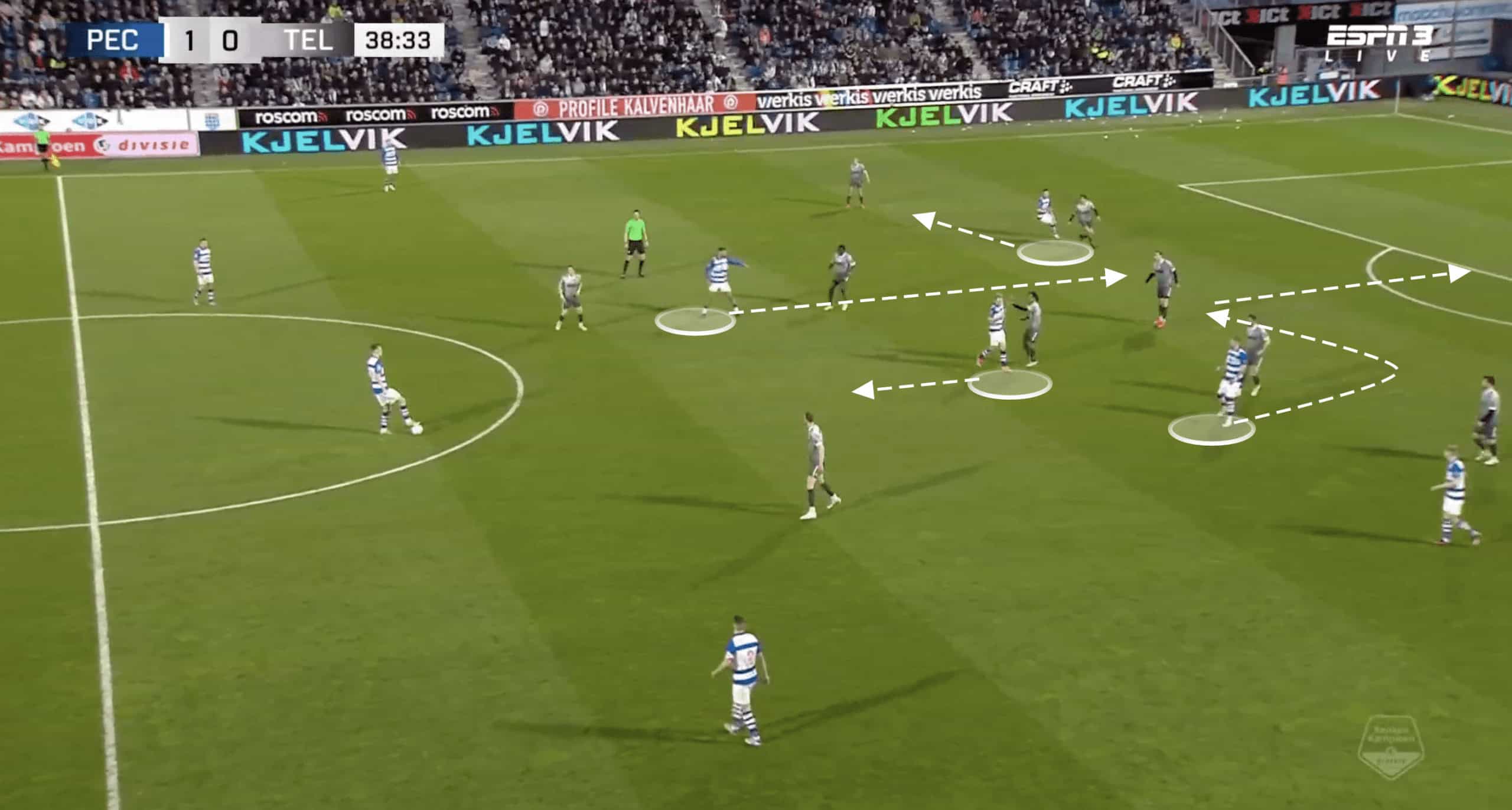
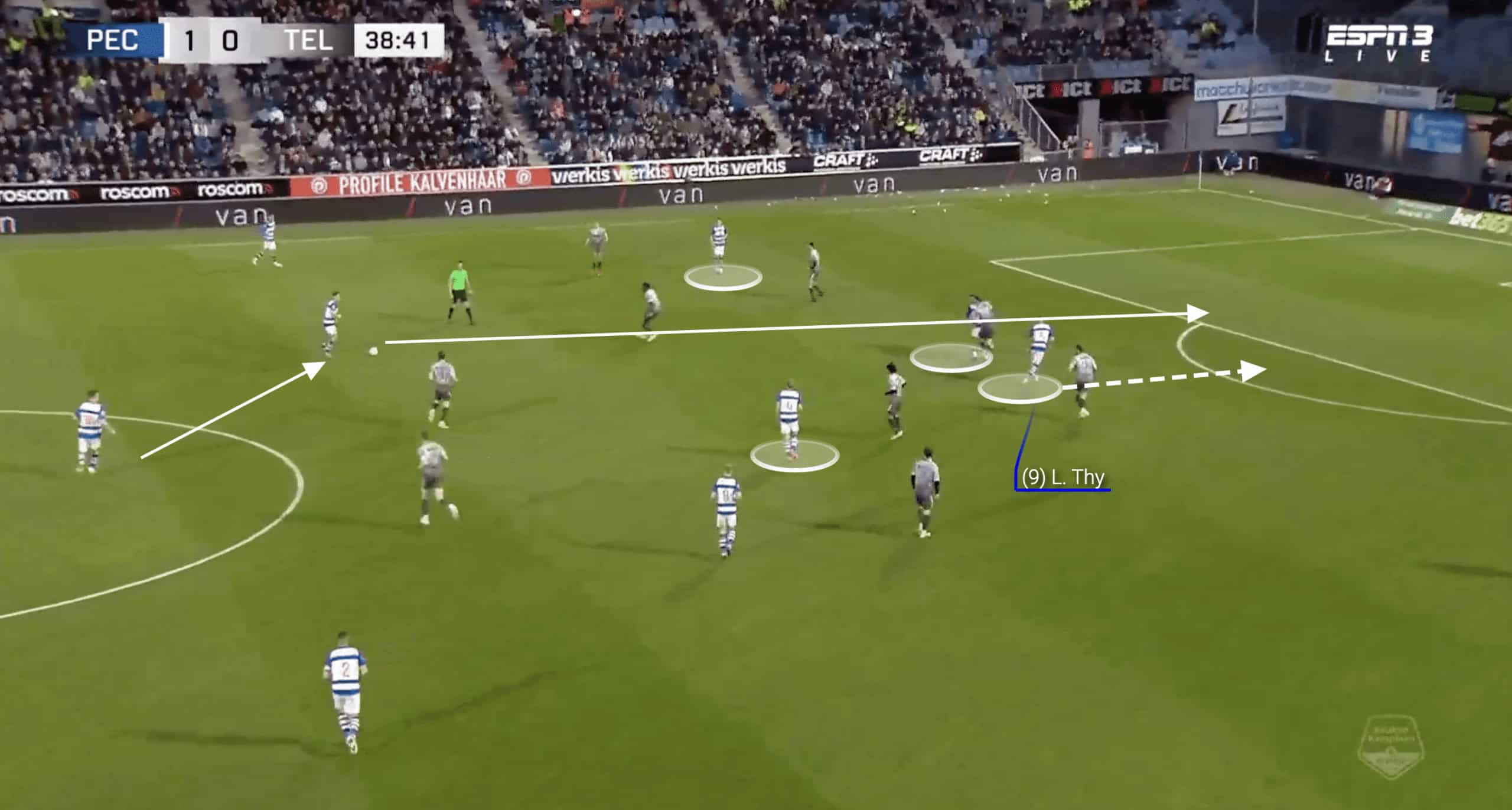
We can see here in Figures 3.1 and 3.2, the Zwolle players rotate their positions to create an opening. Figure 3.1 shows how the players move around the pitch whilst Zwolle remains in possession. Then, in Figure 3.2, which occurs seven seconds after 3.1, we can see the result of those rotations. A passing lane has opened as Lennart Thy makes a run between the two centre-backs and is played through to a 1v1 opportunity against the opposition goalkeeper.
Dick Schreuder’s Zwolle team can be characterised by a high degree of tactical flexibility. His players are encouraged to adapt to changing situations during a game and adjust their play style accordingly. This requires a high level of football intelligence and awareness, which is on show in the images above and below.
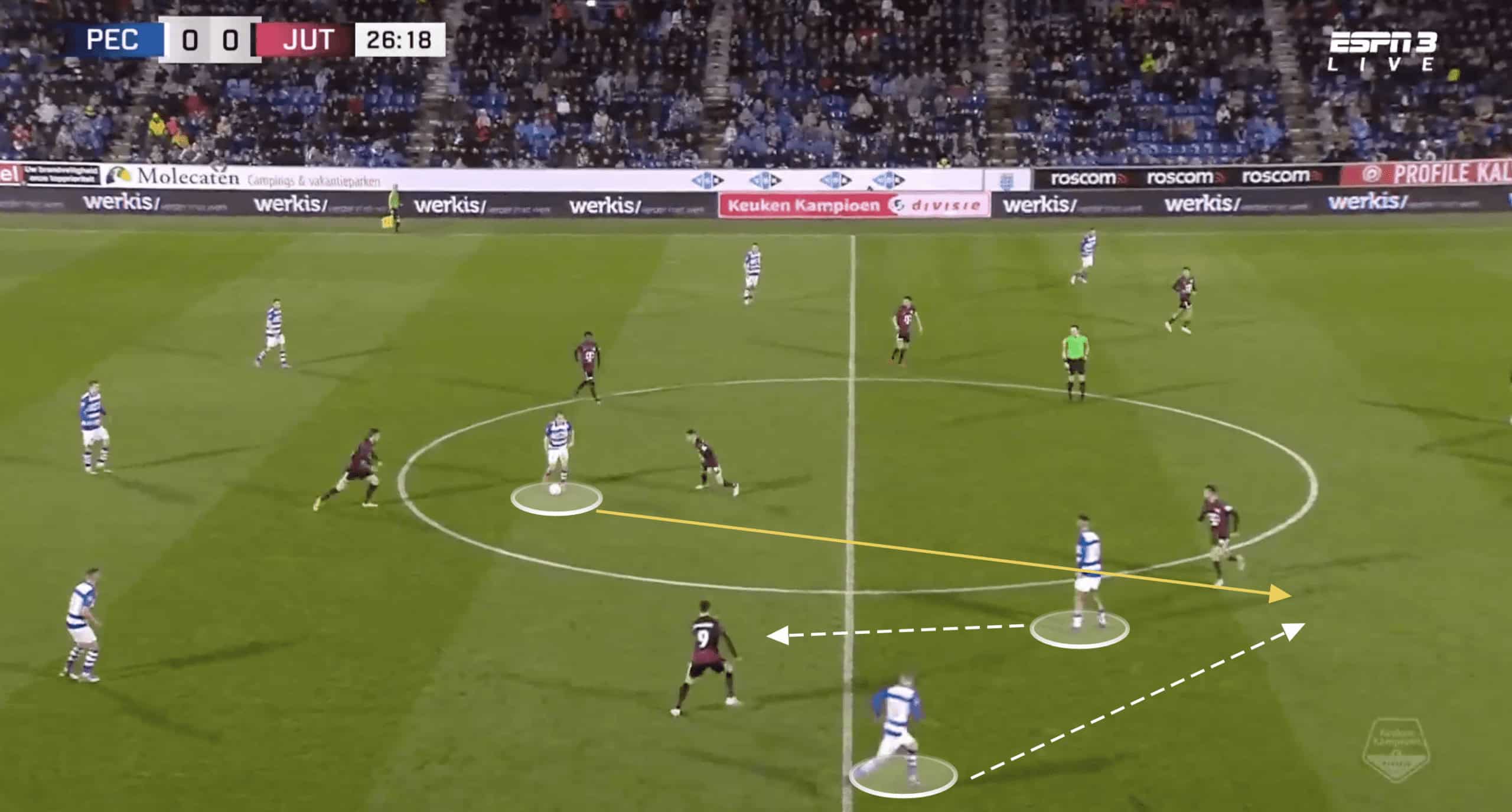
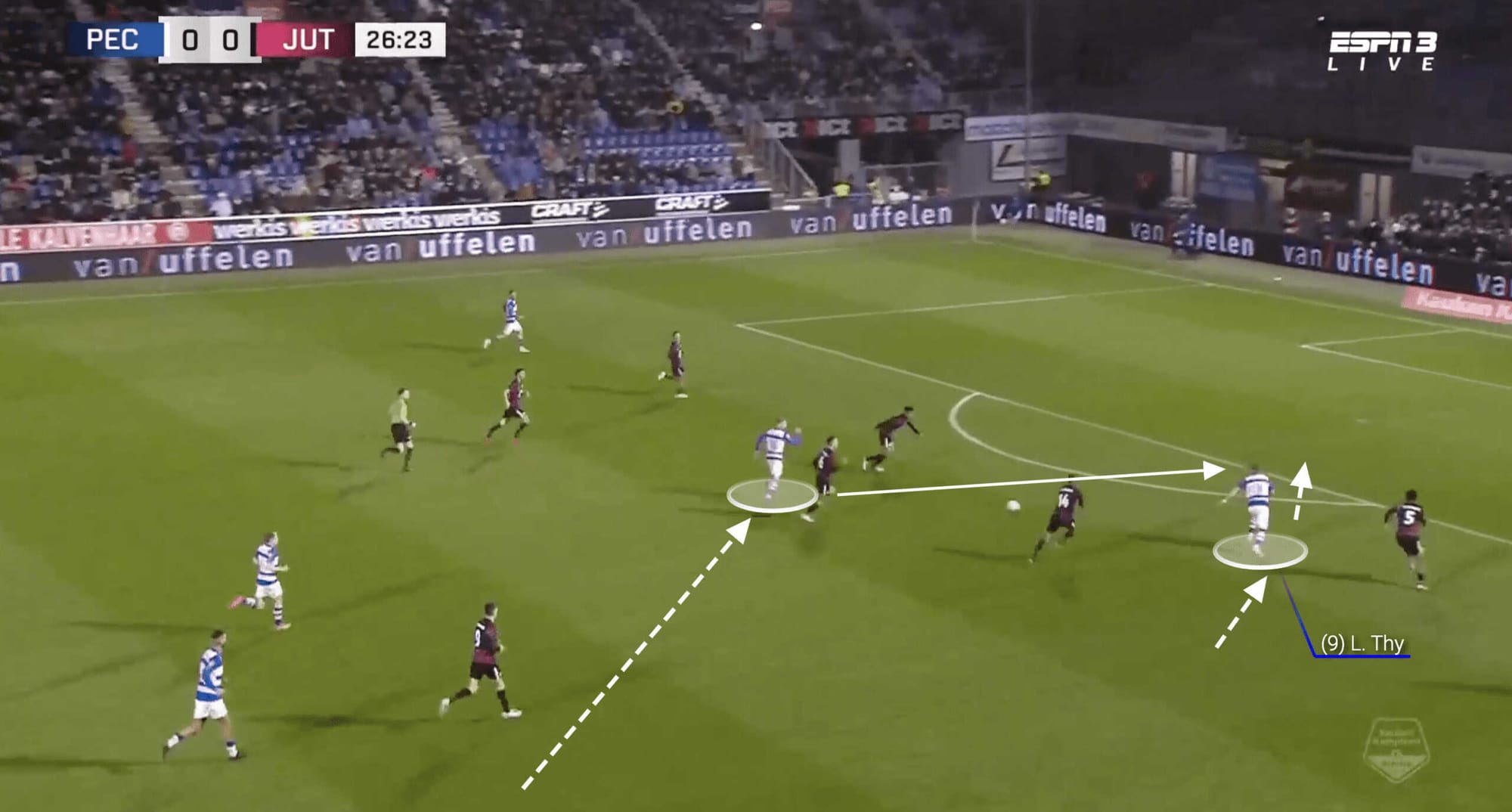
Finally, if we take a look at another key feature of Schreuder’s style of play, we can see the importance placed on individual technical ability. Players are encouraged to demonstrate their skills in the game, especially in dribbling and passing, which allows them to take on opponents and create scoring opportunities.
We can see here in Figure 3.3 that the Zwolle midfielder in possession of the ball is looking for a passing lane. The other highlighted midfielder moves back into the Zwolle half and drags the two opposition players with him, meaning that the wide player can receive the pass. After receiving the ball, he is then able to carry the ball upfield before playing an intricate through pass to Lennart Thy.
Caught on the counter
For all of Zwolle’s attacking prowess during the course of this season, there is no escaping the fact that they concede 1.09 goals per game on average.
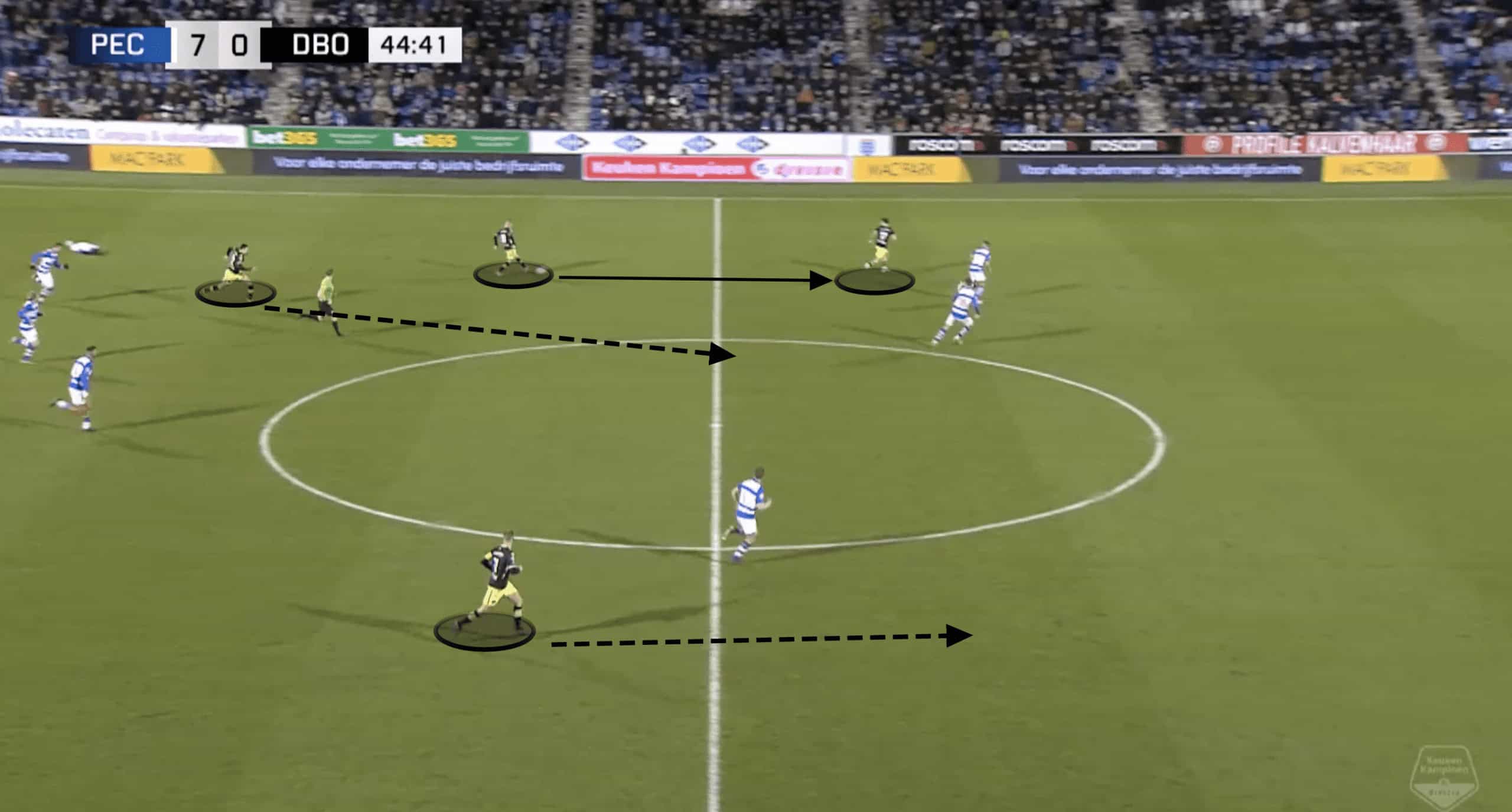
We can see here in Figure 4.1 that PEC Zwolle have committed so many players forward that it does leave them vulnerable to the counterattack. Of course, in this instance, the scoreline is massively in their favour so a little complacency could have set in but this image does demonstrate how an opponent could quickly transition from defence to attack and cause the Zwolle players a problem. Schreuder’s team currently averages 10.91 fouls per game and some of them are likely to be tactical in order to prevent the opposition from launching a counterattack.
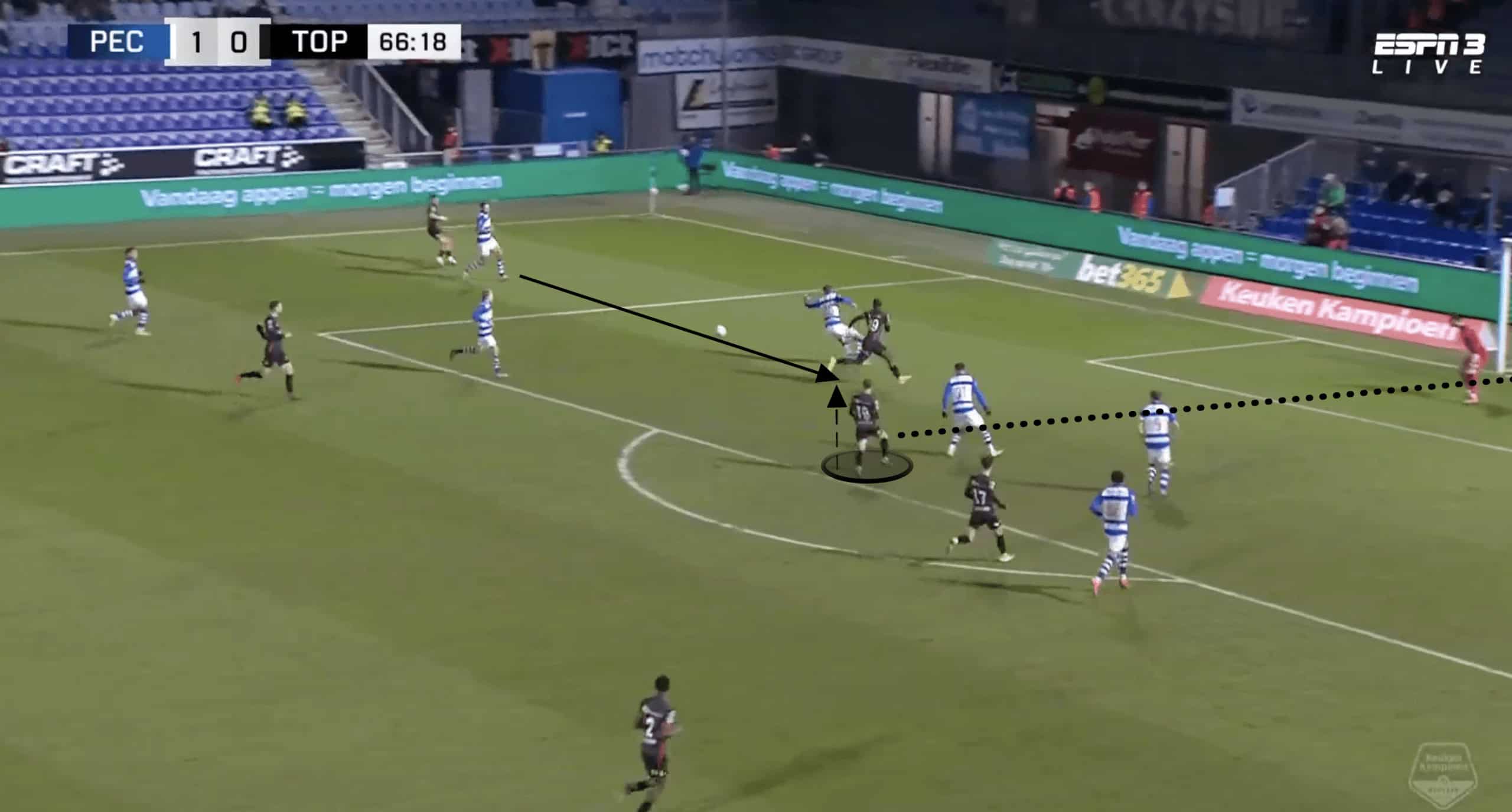
Moreover, in this example shown in Figure 4.2, we can see that the opposition has managed to transition and carry the ball up the field. Zwolle have actually managed to get a good amount of players back to limit the goal-scoring opportunities. However, their positioning is wrong and the cross is easily able to reach the forward player who is able to place the ball beyond the goalkeeper.
It is instances such as this that PEC Zwolle will need to prevent from happening if they are going to succeed in the Eredivisie. Whilst they have been one of, if not the best team in the Eerste Divisie this season, it will be a different situation when they make the jump to the top-flight. There is an argument to say that teams with better players who are able to counter more effectively could take advantage of how many players Zwolle commits forward during an attack.
Conclusion
Overall it has been a phenomenal season for PEC Zwolle under Dick Schreuder. They play some incredibly entertaining and fluid football that has the thread of the football we typically associate with The Netherlands flowing through it. With promotion to the Eredivisie on the horizon, their thoughts will be soon looking ahead to how they can make an impact on the top flight of Dutch football.
It is unlikely that Schreuder will want to compromise his tactical style as players and fans alike seem to enjoy the way his team is playing. The only real concern is whether some teams will look to play counter-attacking football against them which could prove to be costly. Additionally, it will be interesting to see PEC Zwolle in a setting where they may not dominate possession every game. When playing against the likes of Ajax, Feyenoord and PSV it will be intriguing to see if Schreuder alters his tactical philosophy.
All in all though, PEC Zwolle fans will undoubtedly be thrilled with their team being top of the table and playing some highly entertaining football along the way.





Comments